Why ISPs need to rethink now
Customer loyalty can be planned – if you use the right approaches
In competition between Internet providers, price or bandwidth are no longer the only deciding factors. The decisive factor is how good a provider is at meeting its customers' expectations – and continuously develops them. This is exactly where the KANO model comes in: It provides a structured method to classify customer requirements and to strategically implement. For ISPs, it is clear that self-service is no longer a freestyle – but a central basic requirement.
What is the KANO model?
The KANO model divides customer requirements into three main categories:
Basic requirements (must-be)
Self-evident features that are expected – such as a functioning Internet connection or a clear invoice. If they are missing, dissatisfaction immediately ensues.
Performance requirements (one-dimensional)
Requirements where “more” is really “better” – such as a stable connection or fast troubleshooting.
Enthusiasm features (Attractive)
Unexpected services or features that create a positive effect – without being explicitly requested. In the past, this included a self-service platform.
Why self-service is a basic requirement today
Users' expectations have changed. An optional comfort feature has become a fundamental standard:
Solving problems without waiting
Customers want to troubleshoot technical problems independently – fast, digital and anytime.
Reduction of contact costs
Long customer service queues are considered a clear negative feature. Intelligent self-service offers reduce unnecessary inquiries and can respond to the request for 24/7 customer service.
Scalable processes for ISPs
Automated help relieves support – particularly in the case of recurring questions or regional disturbances. This also improves the agent experience.
According to the KANO model, self-service has evolved from an enthusiasm feature to a basic requirement – an important strategic note for every Internet provider.






.webp)





